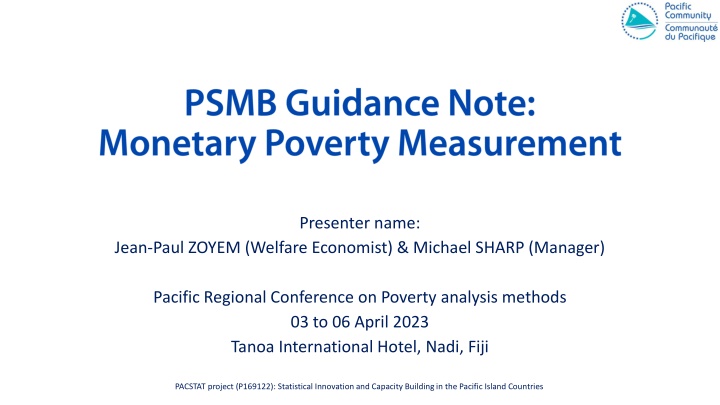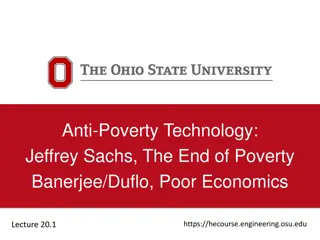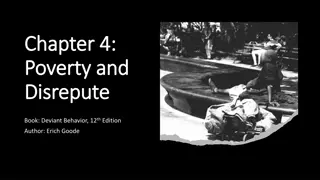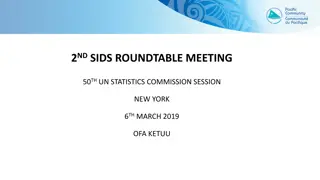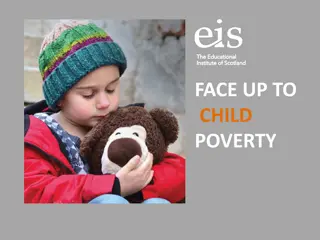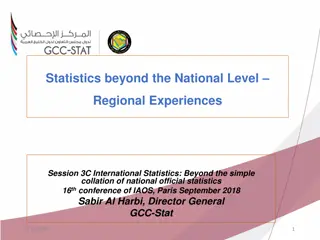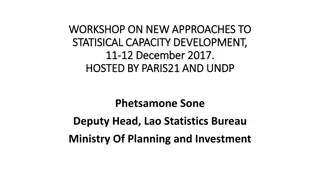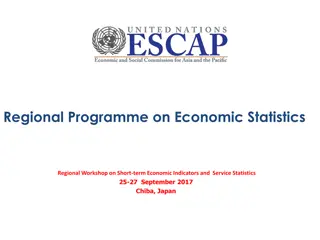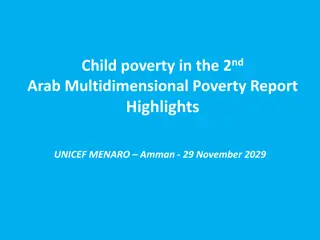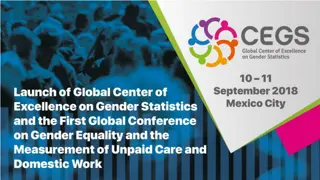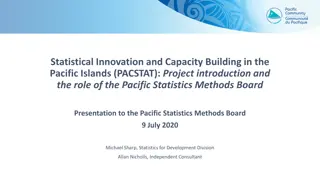Pacific Regional Conference on Poverty Analysis Methods: Enhancing Statistical Capacity
The Pacific Regional Conference on Poverty Analysis Methods, to be held in Fiji, will focus on enhancing statistical capacity in the Pacific Island Countries. The conference will cover topics such as monetary poverty measurement, Cost of Basic Needs approach, and technical capacity building to support welfare data collection and analysis. The event aims to harmonize key welfare indicators and improve poverty measurement practices in the region.
Download Presentation

Please find below an Image/Link to download the presentation.
The content on the website is provided AS IS for your information and personal use only. It may not be sold, licensed, or shared on other websites without obtaining consent from the author.If you encounter any issues during the download, it is possible that the publisher has removed the file from their server.
You are allowed to download the files provided on this website for personal or commercial use, subject to the condition that they are used lawfully. All files are the property of their respective owners.
The content on the website is provided AS IS for your information and personal use only. It may not be sold, licensed, or shared on other websites without obtaining consent from the author.
E N D
Presentation Transcript
Presenter name: Jean-Paul ZOYEM (Welfare Economist) & Michael SHARP (Manager) Pacific Regional Conference on Poverty analysis methods 03 to 06 April 2023 Tanoa International Hotel, Nadi, Fiji PACSTAT project (P169122): Statistical Innovation and Capacity Building in the Pacific Island Countries
Plan of the presentation 1. The PSMB guidance notes series 2. Guidance note on monetary poverty measurement 3. The process of the Cost of Basic Needs (CBN) approach 4. PSMB recommendations on monetary poverty measurement
PSMB Guidance Notes series Capacity building in the PACSTAT project Sub-component 2.1: Expanding Technical Capacity of SPC-SDD : The project supports strengthening technical capacities of the SDD in providing support to the PICs on welfare data collection, analysis and dissemination. Guidance notes support the harmonization of key welfare indicators produced from household income and expenditure surveys, Guidance notes focus on topics that are of universal interest such as: Measurement of monetary poverty Imputation of housing rents Use of fixed assets Microdata dissemination Method for collecting consumption data in the Pacific Sampling methods Measurement of non-monetary poverty Measurement of food away from home
PSMB Guidance Notes series Main features of the Guidance Notes Guidance notes are built on discussions at the PSMB meetings GN For use by NSOs: Indicates how Indicators of monetary poverty can be easily computed, Recommend the good practices in the World, Recommend common practices for the region GN As Live documents to be updated: With formal approval of the Board, Based on new developments on good practices on the issue, Based on the assessment of the HIES analyses following the guidance notes
PSMB Guidance Notes series Process of Guidance notes 1. PSMB request for work research on a given subject of interest for the PICTs 2. SPC carries out the research with support of external expert or not 3. SPC submits a draft of recommendations to PSMB for discussions during board meetings with: Detailed issues that arise in Pacific contexts and suggested ways of addressing them, and A listing of issues for further investigation 4. PSMB addresses recommendations based on research results 5. SPC produces a Guidance note and posts it in the SPC website
Guidance note on Monetary Poverty measurement Board meetings towards PSMB recommendations: October 2018, October 2019, July 2020, September 2020 and October 2022, Board requested the poverty working group to recommend a course of action for poverty measurement, Presentation of the rationale of poverty measurement and a detailed explanation of methodologies for its calculation Proposition of a draft of recommendations to PSMB with listed issues for further investigations Presentation of an annotated agenda on poverty measurement guidelines The Board adopted the guidelines as interim measures Endorsement of the recommendations (October 2022) Mother document of the guidance note: https://purl.org/spc/digilib/doc/57c42). Further discussions on pending questions led to additional recommendations (report of the PSMB July 2020 meeting https://sdd.spc.int/events/2020/04/5th-pacific-statistics-methods-board-psmb-meeting
Monetary poverty Poverty line Poverty line is defined as the level of well-being under which an individual is considered poor. Two monetary poverty lines for the SDGs The international poverty line (SDG1.1.1) for comparison among countries; SDG1.1.1= Proportion of the population living below the international poverty line by sex, age, employment status and geographic location (urban/rural) Calculated by the World Bank using the USD 1.90 PPP per capita per day The national poverty line (SDG1.2.1) for national poverty monitoring SDG1.2.1= Proportion of population living below the national poverty line, by sex and age Based on the Cost-of-Basic-Needs (CBN) approach Using national survey data which takes into account the living conditions Focus of the guidance note
Cost of Basic Needs approach The Cost of basic needs approach (CBN) CBN Bases the measure of poverty on the structure and prices of household consumption Main pillars of the CBN approach Consumption aggregate Poverty line Processing the CBN approach The process chart of the CBN approach Poverty indexes Derivation of poverty indexes from combination of consumption aggregate and poverty line
Cost of Basic Needs : process chart Non food expenditure: Food expenditure: - Non food products eligible for expenditure aggregate - Food products eligible for expenditure aggregate - include imputed rent and use of durables Expenditure aggregate= Food + Non-food expenditure : - Calculate expenditure per capita - Generate the distribution of expenditure per capita (deciles, etc) Food basket : - Calculate food expenditure for the reference households using food products eligible for food basket; Reference households: - Exclude extreme values of expenditure (example: decile 1 & 10) - Calculate the total food expenditure per product; - Calculate product share in total; - Rank products by share, - Select bigest expenditures with cumulated value of 90% of total Non-Food Poverty Line: - Choose among different approaches including: - Regression method basd on an Engel curve; - Ravallion non-parametric methods using spending patterns of households around poverty line Basic Need Poverty Line= Food Poverty line + Non-food Poverty line
Cost of Basic Needs approach The main steps of the process of the CBN approach Data source for the CBN process Consumption aggregate Food poverty line Non-food poverty line Basic need poverty line PSMB recommendations Critical challenges at each step of the CBN process: On data analysis On economics, social and statistical assumptions Requirement of recommendations for comparability among countries
PSMB recommendations Measure of well-being Household consumption aggregates are used to measure well-being Income is an alternative measure of well-being Income is more appropriate for richest economies Income is poor to inform on well-being in poorest economies Consumption is deemed more appropriate for the PICTs. The most appropriate data source to compile consumption aggregate is the Household Income and Expenditure Survey (HIES). Details on the HIES design and implementation are given in the guidance note Method for collecting consumption data in the Pacific (planned). Consumption aggregate includes food and non-food consumption.
PSMB recommendations Food consumption aggregate Compilation of food consumption collected using the 7-day recall methodology, Add up all food spending of the household Adjusting for stocks if using a diary All sources of food consumption: Purchased food Own production In-kind food received Gifts Rations (such as after a natural disaster) All food consumption places: In-house, including prepared meals purchased and brought into the home Prepared meals consumed outside the dwelling purchased or received for free (individual level) Only quantity may be known for Own production, in-kind food, gifts, rations, Value the quantity using Unit prices calculated from consumption survey using corresponding values for the same quantity of purchased goods.
PSMB recommendations Valuing food consumption quantity Some limitations to using Unit prices from consumption survey Number of households who purchased a given good may be too small in the dataset, what compromises the robustness of the unit price derived from the survey, Some purchased foods are recorded in non-standard unit measures. Market survey beside consumption survey Conducted concurrently with the consumption survey. Conducted once in every enumeration area, Collect information on the price and weight of products, by different units. Some concerns about market survey: Poor quality and the discrepancies found when comparing prices from unit values and market values, Especially for perishable goods such as fish, which are important in daily diets.
PSMB recommendations Valuing food consumption quantity Use the best available source of data (market survey, HIES data, etc) When pricing is based on unit prices it is advised to use the median unit values from the lowest area of geographic disaggregation at which stable estimates can be calculated. It is suggested to set a minimum number of observations and to include quality checks. Food away from home in household surveys (FAFH) Captured using 7-day recall At individual level, By meal event such as breakfast, lunch, diner, snack, etc
PSMB recommendations Non-food consumption aggregate Non-food consumption aggregate builds on Spending categories that are more likely to properly reflect the household well-being. However, some expenditures are deemed non-eligible for consumption, While some assets are valued for inclusion in the consumption. Thus, non-food consumption aggregate includes: Eligible non-food spending Imputed rent Use value of durables (assets)
PSMB recommendations Non-food consumption aggregate Non eligible non-food spending includes: Lumpy expenditure or expenses that are large but infrequent, such as weddings, births, deaths, hospitalization, etc. Difficult-to-cost items which are (theoretically) equally available to all individuals (public services and leisure time), Investment and other business-related expenses, Repayment of loans, interest payments, purchase of financial assets, and taxes paid, Transfers out of the household (including gifts, remittances, and religious contributions).
PSMB recommendations Non-food consumption aggregate Health spending Is given a special treatment as certain aspects should certainly be included because they are welfare enhancing (such as preventative care and cosmetic procedures) While some others should be excluded (lumpy expenditures such as hospitalization) Other spendings, including doctor visits and treatment for illness could either be considered a welfare enhancing (and included) or a regrettable necessity (and excluded). PSMB recommendations on health spending in two steps: Design the questionnaire to capture health spending in much more details allowing compilation of three types of health expenditures: preventative and elective care (including routine check-ups and cosmetic procedures), hospitalization and other high priced events, and urgent care (treatment for an illness) Preventative and elective care should be eligible while hospitalization should be non-eligible. Classification of urgent care remains unaddressed.
PSMB recommendations Non-food consumption aggregate Education spending General recommendation is to include education spending; However, inclusion of education can be controversial as some economists see it as an investment (as children will care for parents as they age).
PSMB recommendations Non-food consumption aggregate Use value of household assets Include the Usevalue of household assets rather than asset price itself, Calculate the use value of assets using information from questionnaire and outside sources Data needed for the estimation of the use value of an asset The ownership of the asset by household members, Age of the assets, Mean of acquisition of the assets (purchased new or secondhand, received new or secondhand as gift, etc), The price of the purchased assets (or estimated price if it was given as gift), , The self-estimated cost if the asset was to sell today. In practice, if 2 assets or more, some questionnaires ask detail information for one asset (the main or the most recent), and the total number owned; Depreciation rate of the assets Collected from outside sources including data from Revenue Authority and any other institution that deals with assets, May also be estimated from dedicated surveys on assets.
PSMB recommendations Nonfood consumption aggregate Housing rent Include the equivalent value of housing rent, Estimate imputed rent for non renters (homeowners and user for free) using information from questionnaire Method of estimating the imputed rent Different approaches are used to estimate the rental equivalent, however each of them is subject to some caveats. The recommended approach: Develop an econometric model Using the characteristics of the dwelling; Information to be collected in the questionnaire Actual rent for renters Self-reported imputed rent for non renters: The households is asked what the equivalent rent would be, This question, however, can be hard to answer if no one in the community rents; Information on the dwelling characteristics (building year, building materials, number of rooms, kitchen status, access to water and energy power service, etc)
PSMB recommendations Consumption adjustment Difference in well-being among households Consumption aggregate in itself is not enough to compare well-being among households, across regions or between two periods of time. Some adjustments are needed to make consumption aggregate comparable as well-being indicator. Consumption adjustment consist in taking into account: Household composition (size, adult equivalent measures), Differences in cost-of-living across areas of the country (spatial deflators), and Seasonal variation of prices (temporal deflators).
PSMB recommendations Consumption adjustment for household composition Adult equivalent measures The two main options used to define the household living standard through consumption are: Consumption per capita which divides consumption by the household size and Consumption per adult equivalent which divides consumption by adult equivalent value. Consumption per adult equivalent intents to account for differences in the requirements of adults and children. There is no universal perception of these differences: the proposed values of adult equivalent differ among institutions and researchers. PSMB recommendation is to use the adult equivalent scale which has been commonly used historically in the region; that means assigning the following values: 1 to each adult member of the household, and 0.5 to each child (under 15 years old)
PSMB recommendations Consumption adjustment for household composition Partakers for adjustment of Adult equivalent measure Partakers is a new concept that has recently emerged from the survey literature to address sharing of meals with non-family members. This phenomenon is common in many cultures, particularly in the Pacific, but is rarely reflected in the surveys. PSMB recommendation is to capture the partaker phenomenon during the survey using questions like the followings: In the last 7 days, did any non-household member (visitor) join in a meal consumed in this home. In the last 7 days, how many meals did you share at home with a guest aged 0 to 5 years old? In the last 7 days, how many meals did you share at home with a guest aged 6 to 15? In the last 7 days, how many meals did you share at home with a guest aged 16 to 65?
PSMB recommendations Consumption adjustment for price differences Price deflators: spatial and temporal Main price deflator measures used for price adjustments: Paasche, Laspeyres, and Fisher PSMB recommends to use deflator indexes according to the following scheme: Spatial deflator: Paasche index is recommended Because Paasche index takes into account that households make different consumption decisions when they are faced with different prices. The basket should reflect the consumption of the household s location. Temporal deflator: Fischer index is recommended because: Because both the Paasche and Laspeyres indices have drawbacks for temporal measures. Taking the average between the two mitigates these concerns. Apply these deflators to the nominal household consumption total spending to obtain the final real household consumption.
PSMB recommendations Poverty line process Food basket The Food basket should be defined on a relevant reference population Reference population should be households in the deciles of consumption distribution around the poverty line. At the processing time, however, the poverty line is not yet known. Previous values of poverty lines can hence be used as raw estimate. The top and bottom deciles should be excluded as appropriate if there are outliers in the distribution. Since the food poverty line will change every time the reference population changes, this approach is often an iterative process to fix a robust reference population. Caloric requirements of national population Dietary energy requirements should be based on a normative threshold value Defined as providing the estimated minimum calorie intake consistent with an economically active and healthy life for the average person in the population; From WHO/FAO 2011 Human Energy Requirements and the most recently available population pyramid information. Most of the time poverty analyses in the PICTs fixe the threshold at 2100 kcal/capita/day
PSMB recommendations Poverty line process Food Away From Home (FAFH) FAFH should be taken into consideration in food poverty line since it is a growing share of consumption across the world. The amount spend on FAFH can be easily collected in the questionnaire, but not the quantity Converting this measure into calorie equivalents is more complicated and requires some assumptions. There are two main approaches: Incorporating a food establishment survey into the HIES data collection. This approach collects the composition of common restaurant and street vendor meals by location, which are then converted into calories. Making the assumption that the per-calorie cost of FAFH is the same as or a multiple of the per- calorie cost of food prepared and consumed at home, and that the composition of food eaten in restaurants is similar to that prepared at home. PSMB recommends to adopt a multiplier of 1.25
PSMB recommendations Poverty line process Non-food poverty line Non-food poverty line is constructed using the relationship between food and non-food spending of the reference population. This construction is supported by the main idea that the non-food component of poverty line is the non-food share of total spending by households whose food spending is close to the food poverty line. Several approaches are used to calculate the non-food component of the poverty line, among which: Regression method based on an Engel curve. It uses econometrics models to predict the shape of the curve describing the relationship between food spending and consumption. Ravallion non-parametric approaches: they use the spending patterns of the households around the food poverty line to estimate the non-food share of the poverty line.
PSMB recommendations Poverty line process Ravallion non-parametric approaches Ravallion upper bound poverty line that uses per adult equivalent total food consumption around the food poverty line and proceed as follows: Step 1: Obtain average total per adult equivalent consumption for households whose per adult equivalent food consumption is +/- 1% of the food poverty line. Step 2: Repeat for households around +/- 2%, continuing up to +/- 10%. Step 3: Take average of all averages as the estimate of the non-food component of the total poverty line. Ravallion lower bound poverty line that uses per adult equivalent total consumption around the food poverty line and proceed as follows: Step 1: Obtain average total per adult equivalent consumption for households whose per adult equivalent total consumption is +/- 1% of the food poverty line. Step 2: Repeat for households around +/- 2%, continuing up to +/- 10%. Step 3: Take average of all averages as the estimate of the non-food component of the total poverty line. PSMB recommendation for non-food poverty line Calculate both the Ravallion upper and lower bound and deciding which is most appropriate.
PSMB recommendations Poverty indexes Monetary poverty measures commonly include a set of three measures: Poverty Rate that is the proportion of the population living below the poverty line. Poverty Gap that is the average shortfall, as expressed as a percentage of the poverty line. Squared Poverty Gap that measures the gap to poverty line in giving more weight to those living farer to poverty line. PSMB recommends to calculate these indexes Using the Foster, Greer & Thorbecke (FGT) formula for the corresponding value of 1. = 0 P0 : Poverty Rate (Incidence of poverty) 2. = 1 P1 : Poverty Gap (Depth/Intensity of poverty) 3. = 2 P2 : Squared poverty gap (Severity of poverty/Inequality of consumption) FGT formula in a separate slide
PSMB recommendations (SKIP) Poverty indexes FGT poverty measures defined in a formula by Foster, Greer & Thorbecke (1984) are the most common set of measures used in poverty analysis. ? 1 ? ?=1 ? ?? ? ? ?????,? = where z is the poverty line, ?? is the ?? lowest consumption (or other standard of living indicator), n is the total population, q is the number of persons who are poor, and is a povertyaversion parameter.
PSMB recommendations Poverty trend analysis Poverty trend analysis describes how poverty indicators change over time. Indicators are built on poverty line, therefore it is crucial to address the issue of poverty line change over time. In most countries, the poverty line is only recalculated rarely, perhaps once every 10 15 years Or when a major methodological change is introduced (such as switching to CAPI). For other periods the poverty line from the previous survey is adjusted using CPI data to the midpoint of data collection for the new survey. PSMB recommendation on the Adjustments to the poverty line over time Poverty lines should be updated using the CPI in successive rounds up to the point at which they become obsolete. The line should therefore be updated every 5 10 years or when there has been a significant shift in the economic environment. It is suggested to update food and non-food components separately, provided appropriate, good-quality CPI measures are available.
PSMB recommendations Software for poverty analysis PSMB recommendations on software It is essential that the analyst use a software capable of handling the calculations correctly and maintaining a record of the steps. Possible choices include Stata, R, or SAS. Yet, Excel, while useful for some part of the analysis, cannot be used for the core calculations as it cannot be used to properly do some calculations such as imputed rent ; The do / R files should be retained and archived as part of the survey documentation process
Thank you Address/post: Pacific Community (SPC), 95 Promenade Roger Laroque, BP D5 98848 Noumea, New Caledonia Phone: +687 262000 | Fax: +687 263818 | Email: complaints@spc.int | Web: https://spc.int/accountability
